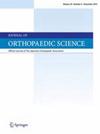采用残余组织保留技术重建前十字韧带的感觉和临床效果:根据保留组织长度进行比较。
IF 1.5
4区 医学
Q3 ORTHOPEDICS
引用次数: 0
摘要
背景:关于保留残余前交叉韧带重建对长期临床和本体感觉结果的影响,目前尚未达成共识。本研究旨在比较两种不同长度的保留残余组织的前交叉韧带重建术后膝关节的本体感觉和临床效果:本研究纳入了61例接受单束前交叉韧带重建术的患者,采用腘绳肌自体移植物保留残余组织的方法,根据残余组织的长度分为两组。残余组织长度≤33%组包括残余组织长度等于或小于1/3的受试者(30人),残余组织长度大于33%组包括残余组织长度大于1/3的受试者(31人)。在膝关节角度为 20°、50° 和 70°时对运动感觉进行评估。临床结果测量包括 Tegner 活动量表、Lysholm 膝关节评分、单腿跳跃测试,以及使用 Biodex 测力计评估的股四头肌和腿筋肌力。膝关节前侧松弛度用 KT2000 关节测量仪测定。对评估结果进行了统计比较:术后≤33%组和>33%组的平均随访时间分别为28.33个月和33.67个月。各组间的 Lysholm 和 Tegner 评分无明显差异(P > 0.05)。此外,各组之间的本体感觉和肌肉力量值显示出相似性(P > 0.05)。残余组织的长度不会影响术后膝关节的稳定性(P > 0.05):结论:接受保留残余组织的前交叉韧带重建术的患者,无论在短期评估中保留组织长度的多少,都能获得相似的本体感觉功能、肌力、前稳定性和临床效果。本文章由计算机程序翻译,如有差异,请以英文原文为准。
Proprioceptive and clinical outcomes of anterior cruciate ligament reconstruction with remnant tissue preservation technique: A comparison according to the preserved tissue length
Background
No consensus is obtained regarding the effects of remnant-preserving ACL reconstruction on long-term clinical and proprioceptive outcomes. This study aimed to compare proprioceptive and clinical outcomes of the knee joint after ACL reconstruction with two different lengths of preserved remnant tissue.
Methods
This study included 61 patients who underwent single-bundle ACL reconstruction with remnant preservation method using hamstring autograft, divided into two groups according to the length of the remnant tissue. Group ≤33% included subjects with equal and less than 1/3 of the remnant preserved (n = 30) and group >33% included subjects with more than 1/3 of the remnant preserved (n = 31). Proprioception was evaluated at 20°, 50°, and 70° knee angles. Clinical outcome measures included Tegner activity scale, Lysholm knee score, single-leg-hop test, and muscle strength of quadriceps femoris and hamstring muscles which was evaluated using Biodex dynamometer. Anterior laxity was determined with a KT2000 arthrometer. A statistical comparison of the assessments was performed.
Results
The mean follow-up time after surgery were 28.33 and 33.67 months for group ≤33% and >33%, respectively. No significant differences were detected for Lysholm and Tegner scores between the groups (p > 0.05). Additionally, proprioception and muscle strength values displayed similarity between the groups (p > 0.05). The length of the remnant tissue did not affect post-operative knee stability (p > 0.05).
Conclusion
Patients who underwent remnant-preserving ACL reconstruction obtained similar proprioceptive function, muscle strength, anterior stability, and clinical results regardless of the amount of preserved tissue length at short-term assessment.
求助全文
通过发布文献求助,成功后即可免费获取论文全文。
去求助
来源期刊

Journal of Orthopaedic Science
医学-整形外科
CiteScore
3.00
自引率
0.00%
发文量
290
审稿时长
90 days
期刊介绍:
The Journal of Orthopaedic Science is the official peer-reviewed journal of the Japanese Orthopaedic Association. The journal publishes the latest researches and topical debates in all fields of clinical and experimental orthopaedics, including musculoskeletal medicine, sports medicine, locomotive syndrome, trauma, paediatrics, oncology and biomaterials, as well as basic researches.
 求助内容:
求助内容: 应助结果提醒方式:
应助结果提醒方式:


